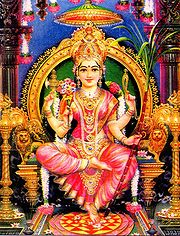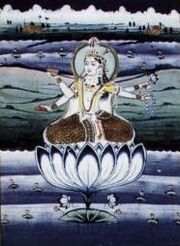
Tripura Sundari
Encyclopedia

Hindu mythology
Hindu religious literature is the large body of traditional narratives related to Hinduism, notably as contained in Sanskrit literature, such as the Sanskrit epics and the Puranas. As such, it is a subset of Nepali and Indian culture...
, collectively called Mahavidya
Mahavidya
Mahavidyas or DashaMahavidyas are a group of ten aspects of the Divine Mother or Devi in Hinduism. The Ten Mahavidyas are Wisdom Goddesses, who represent a spectrum of feminine divinity, from horrific goddesses at one end, to the ravishingly beautiful at the other.The development of Mahvidyas...
s.
As Shodashi, Tripurasundari is represented as a sixteen-year-old girl, and is believed to embody sixteen types of desire. Shodashi also refers to the sixteen syllable mantra, which consists of the fifteen syllable (panchadasakshari) mantra plus a final seed syllable. The Shodashi Tantra refers to Shodashi as the "Beauty of the Three Cities," or Tripurasundari.
Tripurasundari is the primary goddess associated with the Shakta Tantric tradition known as Sri Vidya.The Goddess Who is "Beautiful in the Three Worlds" (Supreme Deity of Srikula systems); the "Tantric Parvati
Parvati
Parvati is a Hindu goddess. Parvati is Shakti, the wife of Shiva and the gentle aspect of Mahadevi, the Great Goddess...
" or the "Moksha Mukuta".
Etymology

The 'three cities' esoterically refers to a variety of interpretive doctrines, but commonly refers to the triple form of the goddess as found in the triadic doctrine of Shaktism. According to Bhaskararaya
Bhaskararaya
Bhaskararaya is widely considered an authority on all questions pertaining to the worship of the Mother Goddess in Hinduism. The worship of Shakti involves many hidden meanings of mantras and coded passages. It is said that these meanings were revealed to Bhaskararaya by the Goddess Herself...
's commentary of the Tripura Upaniṣad:
- There are three forms of deity: physical (sthūla), subtle (sūkṣma) and supreme (parã). Now the first [physical anthropomorphic form of the deity] is described in its respective meditative verses (dhyānaśloka); the second [subtle form] consists of the [particular deity's] respective root-mantra (mūlamantra); the third [supreme or transcendent form] consists of contemplative worship [of the deity's yantra]. Because deities are threefold in form, contemplative worship (upãsti) is divided threefold respectively into external sacrifice (bahiryãga) [performed primarily to the physical form of the deity], silent repetition (japa) [on the subtle form root-mantra] and internal sacrifice (antaryãga) [in the form of contemplative worship (upãsti) of the yantra].
- Even though the bindu cakra [the "drop" in the center of the śrīcakra, is only one point] it has a threefold nature... The three deities created [and] not different from [her supreme] peaceful (śãnta) [aspect] are [the three creative powers,namely,] Icchãśakti, Jñānaśakti, and Kriyāśakti. The female deities named Vāmā, Jyeṣṭhã, and Raudrī [identified with the three śaktis are complemented] by the three [male consort] forms of Brahmã, Viṣṇu, and Rudra which are not different creations from [her all-subsuming aspect called] Ambikā.
Icchãśakti is literally the 'power of will,' Jñānaśakti is the 'power of knowledge,' and Kriyāśakti is the 'power of action.'
Brooks further notes:
- The traditional interpretation of Tripurã's name in Tantric soteriology involves a rather technical discussion of different levels of spiritual insight and worldly accomplishment, the fate of the individual soul (ātman) in the karmic process, and the concepts of external (bahir-) and internal sacrifice (antaryāga).
Tripura also refers to the Śrĩcakra, the yantra that represents the highest vibrational form of Tripurasundari, according to the commentator on the sutra of Gauḍapādā. Bhaskararaya
Bhaskararaya
Bhaskararaya is widely considered an authority on all questions pertaining to the worship of the Mother Goddess in Hinduism. The worship of Shakti involves many hidden meanings of mantras and coded passages. It is said that these meanings were revealed to Bhaskararaya by the Goddess Herself...
notes in his commentary on Tripura Upaniṣad that the śrĩcakra, composed of nine interlocking triangles, is triple in nature.
Iconography
Tripurasundari is described as being of dusky, red, or golden in color, depending on the meditational form, and in union with ShivaShiva
Shiva is a major Hindu deity, and is the destroyer god or transformer among the Trimurti, the Hindu Trinity of the primary aspects of the divine. God Shiva is a yogi who has notice of everything that happens in the world and is the main aspect of life. Yet one with great power lives a life of a...
. The couple are traditionally portrayed on a bed, a throne, or a pedestal that is upheld by Brahma
Brahma
Brahma is the Hindu god of creation and one of the Trimurti, the others being Vishnu and Shiva. According to the Brahma Purana, he is the father of Mānu, and from Mānu all human beings are descended. In the Ramayana and the...
, Vishnu
Vishnu
Vishnu is the Supreme god in the Vaishnavite tradition of Hinduism. Smarta followers of Adi Shankara, among others, venerate Vishnu as one of the five primary forms of God....
, Shiva
Shiva
Shiva is a major Hindu deity, and is the destroyer god or transformer among the Trimurti, the Hindu Trinity of the primary aspects of the divine. God Shiva is a yogi who has notice of everything that happens in the world and is the main aspect of life. Yet one with great power lives a life of a...
, and Indra
Indra
' or is the King of the demi-gods or Devas and Lord of Heaven or Svargaloka in Hindu mythology. He is also the God of War, Storms, and Rainfall.Indra is one of the chief deities in the Rigveda...
. She holds five arrows or flowers, a noose, a goad and a sugarcane or bow. The noose represents attachment, the goad represents repulsion, the sugarcane bow represents the mind and the arrows are the five sense objects.
Bala Tripurasundari is another form of Tripurasundari that is pictured either as an independent young goddess who is 16 years of age, or as an unmarried, pre-menarche girl of nine or ten years of age, also known as a kumari
Kumari
Kumari, or Kumari Devi, is the tradition of worshipping young pre-pubescent girls as manifestations of the divine female energy or devi in Hindu religious traditions. Kumari means young unmarried girl. Kumari word is derived from Sanskrit word Kaumarya meaning "virgin". In Nepali and some Indian...
. Bala Tripurasundari's mantra differs slightly from that of Maha Tripurasundari.
Tripurasundari is also worshipped as the Sri Yantra, which is considered by practitioners of Sri Vidya to be a more true representation of the goddess.
Tripurasundari is an epithet for goddess Parvati
Parvati
Parvati is a Hindu goddess. Parvati is Shakti, the wife of Shiva and the gentle aspect of Mahadevi, the Great Goddess...
. Tripurasundari combines in her being Kali
Kali
' , also known as ' , is the Hindu goddess associated with power, shakti. The name Kali comes from kāla, which means black, time, death, lord of death, Shiva. Kali means "the black one". Since Shiva is called Kāla - the eternal time, Kālī, his consort, also means "Time" or "Death" . Hence, Kāli is...
's determination and Durga’s
Durga
For the 1985 Hindi Film of Rajesh Khanna see DurgaaIn Hinduism, Durga ; ; meaning "the inaccessible" or "the invincible"; , durga) or Maa Durga "one who can redeem in situations of utmost distress" is a form of Devi, the supremely radiant goddess, depicted as having eighteen arms, riding a lion...
charm, grace, and complexion. She has a third eye on her forehead. Usually four-armed and clad in red, the richly bejeweled Tripurasundari sits on a lotus seat laid on a golden throne. She carries in her hands various attributes associated with Shiva
Shiva
Shiva is a major Hindu deity, and is the destroyer god or transformer among the Trimurti, the Hindu Trinity of the primary aspects of the divine. God Shiva is a yogi who has notice of everything that happens in the world and is the main aspect of life. Yet one with great power lives a life of a...
. An aura of royalty characterizes her overall bearing and ambiance.
Influences on Indian History and Culture
The IndiaIndia
India , officially the Republic of India , is a country in South Asia. It is the seventh-largest country by geographical area, the second-most populous country with over 1.2 billion people, and the most populous democracy in the world...
n state
States and territories of India
India is a federal union of states comprising twenty-eight states and seven union territories. The states and territories are further subdivided into districts and so on.-List of states and territories:...
of Tripura
Tripura
Tripura is a state in North-East India, with an area of . It is the third smallest state of India, according to area. Tripura is surrounded by Bangladesh on the north, south, and west. The Indian states of Assam and Mizoram lie to the east. The capital is Agartala and the main languages spoken are...
derives its name from the goddess Tripura Sundari. Her main temple, the Tripura Sundari temple
Tripura Sundari temple
Tripura Sundari Temple is situated in the ancient Udaipur, about 55 km from Agartala, believed to be one of the holiest Hindu shrines in this part of the country. Popularly known as Matabari, crowns in a small hillock and is served by the red-robed priests who traditionally, minister to the mother...
is also located on top of the hills near Radhakishorepur village, a little distance away from Udaipur town.
Kashmiri Pandits have a collection of five ancient hymns, collectively known as Panchastavi, that were composed ages ago in praise of Tripura Sundari. These ancient hymns still remain very popular among this community.
Sri Ramakrishna worshipped his wife Ma Sarada Devi
Sarada Devi
Sarada Devi , born Saradamani Mukhopadhyaya , was the wife and spiritual counterpart of Ramakrishna Paramahamsa, a nineteenth century mystic of Bengal. Sarada Devi is also reverentially addressed as the Holy Mother by the followers of the Ramakrishna monastic order...
as Tripura Sundari during their lives.
Further reading
- Kinsley, David. Hindu Goddesses: Vision of the Divine Feminine in the Hindu Religious Traditions. Berkeley: University of California Press, 1998.
- Dikshitar, V.R. Ramachandra. The Lalita Cult. Delhi: Motilal Banarsidass Publishers Pvt Ltd, 1991.
- Brooks, Douglas R. The Secret of the Three Cities: An Introduction to Hindu Sakta Tantrism. Chicago & London: University of Chicago Press, 1990.
- Brooks, Douglas R. Auspicious Wisdom. Albany: State University of New York Press, 1992.

